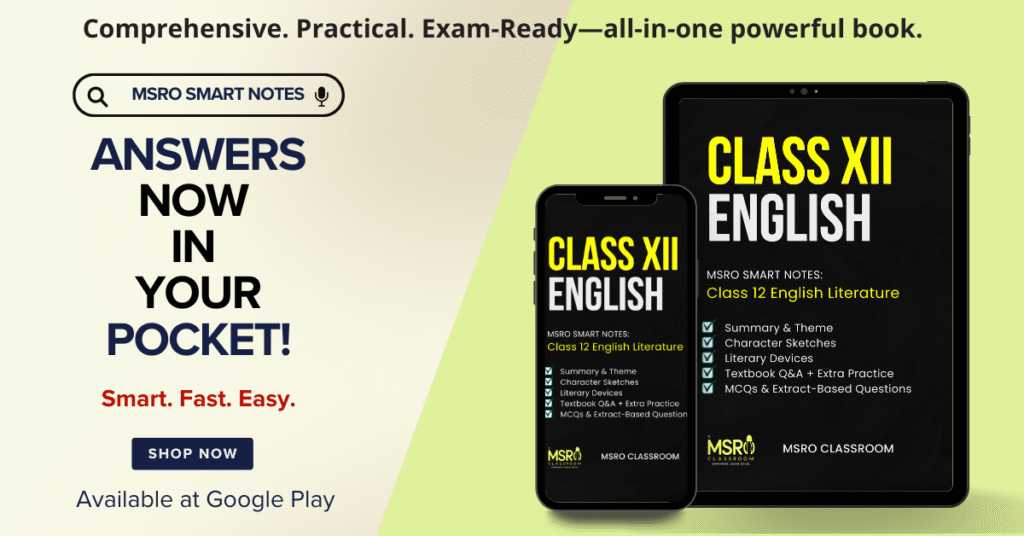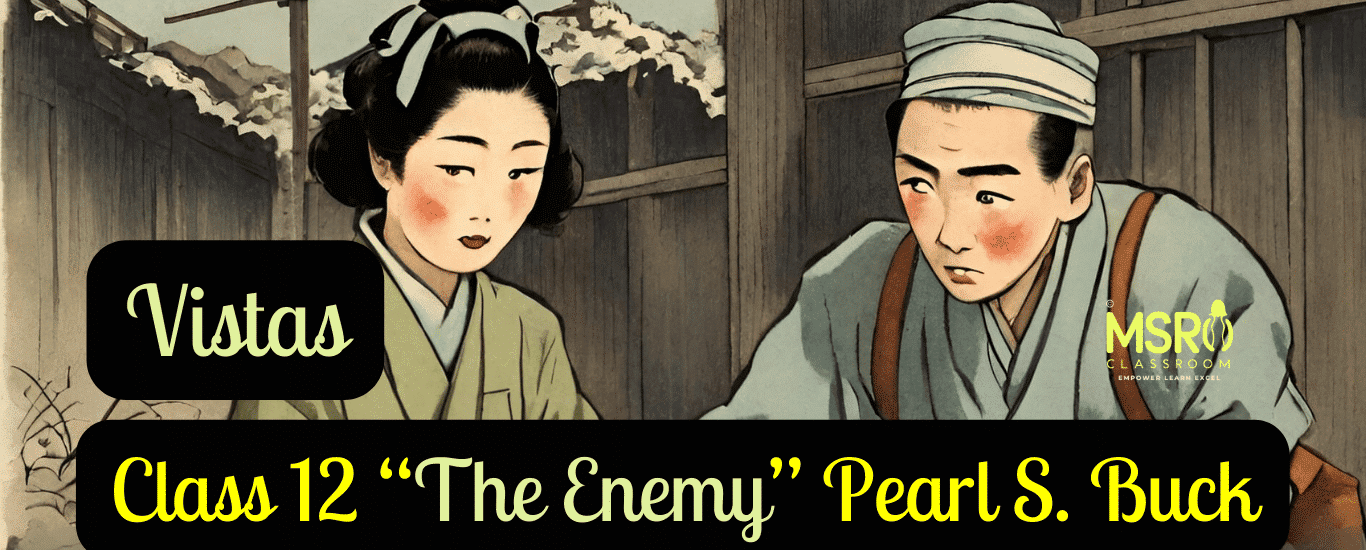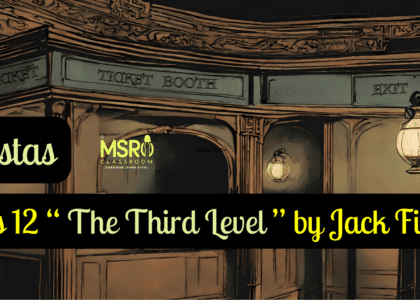Vistas “The Enemy” by Pearl S. Buck- Summary, Theme, Character Sketch, Reading With Insight Q/A and Extra Questions.
Chapter 4- The Enemy Summary, Theme & Explanation
Table of Contents
Next on Vistas: Susan Hill’s “On The Face Of It” Summary and Explanation
Summary ‘The Enemy’ by Pearl S. Buck:
‘The Enemy’ by Pearl S. Buck is a wartime tale set in Japan, focusing on Dr. Sadao and his wife Hana’s moral dilemma when they find an injured American soldier. Despite societal pressures, Sadao saves the soldier’s life, sparking tensions in their household and community.
As suspicions grow, Sadao grapples with his allegiance to his country and his duty to save lives, while Hana struggles with conflicting emotions. When faced with the choice to hand over the soldier or dispose of him secretly, Sadao arranges for his escape, unable to bring himself to kill him.
Through the character of Sadao, the story explores themes of morality, duty, compassion, and the complexity of human relationships in times of conflict. It highlights the struggle between individual conscience and societal expectations and the blurred lines between loyalty to one’s country and the universal value of human life.

SHOP: MSRO SMART NOTES: Class 12 English Literature
Theme ‘The Enemy’ by Pearl S. Buck:
Moral Dilemmas in Times of Conflict: The theme of “The Enemy” by Pearl S. Buck revolves around the complexities of morality, loyalty, and humanity in times of war and conflict. It explores the internal conflict individuals face when their ethics clash with their societal obligations and national loyalties. The story delves into the moral dilemma of prioritising individual compassion and mercy over allegiance to one’s country and duty.
It also examines themes of forgiveness, redemption, and the transformative power of human connection across cultural and ideological boundaries. The story highlights the universal struggle to reconcile personal conscience with societal expectations, especially when moral choices have profound consequences.
Explanation of ‘The Enemy’ for Auditory Learners:
Duration: 9 minutes
Chapters/time stamps with English subtitles are available.
Character Sketch ‘The Enemy’:
1. Character Sketch: Sadao Hoki
- Background: Sadao is a Japanese surgeon from a family with a tradition of medical expertise. He is well-educated and skilled in his profession.
- Professional Integrity: Sadao takes great pride in his medical abilities and is committed to saving lives regardless of the circumstances. He demonstrates a strong sense of duty to his profession and patients.
- Moral Dilemma: When Sadao encounters the American prisoner of war, he faces a profound ethical dilemma. Despite knowing the risks to his safety and reputation, Sadao saves the prisoner’s life, reflecting his deep-rooted compassion and dedication to his Hippocratic oath.
- Internal Conflict: Sadao grapples with conflicting emotions and ethical considerations throughout the story. His decision to shelter the American prisoner puts him at odds with societal expectations and loyalty to his country.
- Sense of Responsibility: Despite the personal risks involved, Sadao feels responsible for ensuring the well-being of the American prisoner under his care. He navigates the delicate balance between his professional obligations and allegiance to his country.
- Evolution: Sadao transforms as he confronts the complexities of wartime ethics and the human cost of conflict. His experiences challenge his preconceptions and force him to reevaluate his values and beliefs.
2. Character Sketch: Hana
- Background: Hana is Sadao’s wife and shares his upbringing and education. She has experienced life in America and brings a perspective influenced by her time there.
- Adaptability: Hana demonstrates adaptability, having adjusted to life in both Japan and America. Exposure to different cultures gives her a nuanced understanding of societal expectations and human behaviour.
- Domestic Responsibilities: As the household mistress, Hana manages domestic affairs and supports Sadao in his professional endeavours. She is depicted as a caring mother and wife, prioritising the well-being of her family.
- Conflict of Loyalties: Hana faces a conflict of loyalties between her allegiance to her husband and her sense of duty to her country. She grapples with the implications of sheltering an enemy soldier and the potential consequences for her family and reputation.
- Internal Struggle: Throughout the story, Hana experiences internal turmoil as she navigates the moral complexities of wartime Japan. Her inner conflict reflects the societal tensions and ethical dilemmas prevalent during the era.
- Resilience: Despite her challenges, Hana is resilient and determined to preserve her family’s integrity and navigate the turbulent political climate. Her strength lies in her ability to confront adversity with grace and composure.
Question Answers ‘The Enemy’: Pearl S. Buck:
Reading with Insight:
Q1: There are moments in life when we have to make hard choices between our roles as private individuals and as citizens with a sense of national loyalty. Discuss with reference to the story you have just read.
A1: In “The Enemy,” Dr. Sadao faces the moral dilemma of treating an enemy soldier who washes ashore near his home. Despite his duty as a citizen and a sense of national loyalty to Japan, he prioritises his role as a doctor and provides medical care to the soldier.
This conflict highlights the tension between personal ethics and national allegiance. Similarly, individuals in real life may encounter situations where they must balance their obligations as private individuals with their responsibilities as citizens, especially in times of war or conflict.
Q2: Dr Sadao was compelled by his duty as a doctor to help the enemy soldier. What made Hana, his wife, sympathetic to him in the face of open defiance from the domestic staff?
A2: Hana, Dr Sadao’s wife, sympathises with him in helping the enemy soldier because she understands the ethical duty of a doctor to save lives regardless of nationality. Despite facing open defiance from the domestic staff and societal pressure, Hana supports her husband’s decision out of compassion and a shared belief in the sanctity of human life.
Her empathy and understanding strengthen their bond and illustrate the importance of standing by loved ones in difficult circumstances.
Q3: How would you explain the reluctance of the soldier to leave the shelter of the doctor’s home even when he knew he couldn’t stay there without risk to the doctor and himself?
A3: The soldier’s reluctance to leave the shelter of the doctor’s home despite knowing the risks reflects his vulnerability and fear of the unknown. He may feel a sense of safety and security within the confines of the house, especially considering his precarious situation as an enemy in a foreign land. Additionally, the soldier may be hesitant to venture out alone into an unfamiliar and potentially hostile environment, preferring the relative safety of the doctor’s care despite the dangers it poses to both of them.
Q4: What explains the attitude of the General in the matter of the enemy soldier? Was it human consideration, lack of national loyalty, dereliction of duty or simply self-absorption?
A4: The General’s attitude toward the enemy soldier appears to be driven by a combination of factors. While he initially promises to have the soldier killed, he later forgets his promise due to his own health concerns and self-absorption. The General’s actions stem from a sense of pragmatism, prioritising his well-being over his duty to eliminate the enemy.
His wavering commitment reflects the complexities of human nature, where self-interest and personal considerations often influence decision-making, even among those in positions of authority.
Q5: While hatred against a member of the enemy race is justifiable, especially during wartime, what makes a human being rise above narrow prejudices?
A5: Rising above narrow prejudices often requires empathy, compassion, and a recognition of shared humanity. While hatred against the enemy race may be justifiable in the context of war, individuals can transcend these prejudices by acknowledging the intrinsic worth and dignity of every human being.
Compassion, understanding, and the ability to see beyond surface differences enable individuals to empathise with others, fostering mutual respect and reconciliation even in times of conflict.
Q6: Do you think the doctor’s final solution to the problem was the best possible one in the circumstances?
A6: The doctor’s final solution to the problem, allowing the enemy soldier to escape to a nearby island, may be considered the best option given the circumstances. By facilitating the soldier’s departure, the doctor ensures the safety of himself and the soldier while avoiding potential repercussions from authorities. While the decision may not be ideal, it reflects the doctor’s commitment to preserving life and minimising harm in a challenging situation.
Q7: Does the story remind you of ‘Birth’ by A. J. Cronin that you read in Snapshots last year? What are the similarities?
A7: “The Enemy” shares similarities with “Birth” by A.J. Cronin regarding the protagonists’ ethical dilemmas and moral complexities. Both stories explore themes of duty, compassion, and the inherent value of human life.
They depict characters grappling with conflicting loyalties and navigating the moral grey areas of wartime situations. While the specific contexts and plot details may differ, the underlying themes of morality and human compassion resonate across both narratives.
Q8: Is there any film you have seen or novel you have read with a similar theme?
A8: One film with a similar theme movie with a similar theme is “Schindler’s List,” directed by Steven Spielberg. The film tells the true story of Oskar Schindler, a German businessman who saved the lives of over a thousand Polish Jews during the Holocaust by employing them in his factories. “Schindler’s List” explores themes of compassion, moral responsibility, and the resilience of the human spirit in the face of extreme adversity. Like “The Enemy,” it portrays individuals who defy societal norms and risk their safety to protect others from persecution and violence. The movie highlights the capacity for heroism and selflessness even in the darkest times.

SHOP: MSRO SMART NOTES: Class 12 English Literature
Extra Questions ‘The Enemy’ by Pearl S. Buck:
Short Answer Type Questions:
1: What internal conflict does Dr. Sadao face regarding the wounded American soldier?
A1: Dr. Sadao grapples with the dilemma of whether to save the wounded soldier as a doctor or hand him over to the authorities as a patriot. He realises the potential risks and consequences of harbouring an enemy in his home.
Q2: What is Hana’s reaction to finding the wounded American soldier?
A2: Hana is initially shocked and hesitant about the presence of the wounded soldier. She shares Sadao’s concerns about the potential consequences of helping him and exhibits compassion and a sense of duty toward him.
Q3: How do Dr. Sadao and Hana decide to handle the situation?
A3: They ultimately decide to take the wounded soldier into their home and provide medical assistance despite the risks involved. They plan to eventually turn him over to the authorities as a prisoner of war.
Q4: What reservations does Hana have about assisting the wounded soldier?
A4: Hana is conflicted and fearful about the repercussions of helping the wounded soldier. She worries about the safety of her family and the potential consequences of harbouring an enemy.
Q5: How does Dr. Sadao react to operating on the wounded soldier?
A5: Dr. Sadao initially hesitates but ultimately decides to operate on the wounded soldier. Despite his conflicted feelings about the situation, he exhibits professionalism and determination in carrying out the surgery.
Q6: What dilemma does Dr. Sadao face during the surgery?
A6: During the surgery, Dr. Sadao faces the dilemma of whether to save the wounded soldier’s life despite considering him an enemy. He wrestles with his professional duty as a surgeon and loyalty to his country.
Q7: What conflicting emotions do Dr. Sadao and Hana experience throughout the ordeal?
A7: Dr. Sadao and Hana experience a mix of compassion, fear, duty, and patriotism throughout the ordeal. They must navigate their personal feelings while confronting their ethical and moral complexities.
Q8: Discuss the implications of Dr Sadao’s decision to operate on the wounded soldier for his professional reputation and personal safety.
A8: Dr. Sadao’s decision to perform surgery on the injured soldier jeopardises his professional reputation and places him at risk of repercussions from the authorities. His actions underscore the ethical dilemmas faced by individuals torn between professional duty and national loyalty during wartime.
Q9: How does the wounded soldier’s unconscious state challenge Dr. Sadao and Hana’s perceptions of the enemy?
A9: The injured soldier’s unconsciousness deprives Dr Sadao and Hana of the opportunity to confront him as a human being, forcing them to grapple with their preconceived notions and prejudices about the enemy in a state of vulnerability and powerlessness.
Q10: What was Sadao’s initial reaction to the injured man’s presence in his house?
A10: Sadao initially felt conflicted about the wounded man’s presence. Despite considering turning him over to the authorities as a prisoner of war, Sadao ultimately chose to save his life, driven by his medical training and moral duty.
Long Answer Type Questions:
Q1: How does Sadao’s internal conflict between his duty to his country and his humanitarian instincts drive the narrative forward in the story?
A1: Sadao’s inner conflict between his duty to his country and his humanitarian instincts serves as a central driving force in the narrative, shaping the decisions and actions of the characters.
As a skilled surgeon and a Japanese citizen, Sadao feels torn between his allegiance to his nation, which views Americans as enemies during wartime, and his professional oath to save lives. This conflict intensifies as Sadao becomes responsible for the care of an American prisoner of war, forcing him to confront the human face of his country’s enemy.
The tension between duty and compassion propels the plot forward as Sadao grapples with ethical dilemmas, such as whether to report the prisoner to authorities or to prioritise his duty as a healer. Ultimately, this internal struggle drives Sadao to make difficult choices that challenge societal norms and reveal the complexities of human morality in times of conflict.
Q2: What role does Hana play in Sadao’s decision-making process regarding the American prisoner, and how does her presence influence the moral and ethical dimensions of their actions?
A2: Hana serves as a moral compass and a voice of conscience in Sadao’s decision-making process regarding the American prisoner.
Her presence introduces a contrasting perspective to Sadao’s internal conflict, adding depth to their actions’ moral and ethical dimensions. While Sadao grapples with his duty as a Japanese citizen and a skilled surgeon, Hana represents a softer, more empathetic approach rooted in compassion and humanity.
She questions the societal norms and expectations placed upon them, challenging Sadao to reconsider the implications of their decisions beyond patriotic duty. Hana’s influence highlights the complexities of human relationships and the moral ambiguity inherent in wartime situations.
Through her character, the narrative explores themes of empathy, compassion, and the intrinsic humanity that transcends national boundaries, prompting Sadao to confront the moral dilemmas surrounding the prisoner’s fate.
Q3: In what ways does the relationship between Sadao and the General symbolise the broader tensions and complexities within Japanese society during the wartime context of the story?
A3: The relationship between Sadao and the General symbolises the broader tensions and complexities within Japanese society during the wartime context of the story in several ways. Firstly, it reflects the hierarchical structure and power dynamics prevalent in Japanese society, where obedience to authority figures like the General is paramount. Sadao’s loyalty to the General represents the pervasive influence of militaristic values and the duty-bound ethos ingrained in Japanese culture during wartime.
Moreover, the dynamic between Sadao and the General highlights individuals’ moral compromises to navigate oppressive systems. Sadao’s dilemma regarding the American prisoner exemplifies the internal conflict faced by many Japanese citizens torn between national allegiance and personal ethics. The tension between duty and morality is a recurring theme mirrored in the broader societal struggles against oppressive regimes, illustrating the complexities of navigating individual conscience within authoritarian contexts.
Q4: Can Sadao’s decision to let the American prisoner escape be interpreted as an act of defiance against the rigid social and political structures of wartime Japan?
A4: Sadao’s decision to allow the American prisoner to escape can indeed be interpreted as an act of defiance against the rigid social and political structures of wartime Japan. In a society where obedience to authority and adherence to nationalistic ideals were highly valued, Sadao’s choice to prioritise humanitarian concerns over allegiance to the state represents a subtle form of resistance against oppressive norms.
By aiding the prisoner’s escape, Sadao challenges the notion of absolute loyalty to the state and demonstrates a willingness to prioritise individual morality and compassion. His actions suggest a rejection of blind conformity to militaristic values and asserting personal autonomy in the face of authoritarian control.
Sadao’s defiance reflects a deeper yearning for human connection and empathy, transcending nationalistic divides and highlighting the universal significance of compassion and individuals’ moral compromises.
Q5: How does the story’s resolution reflect Sadao’s internal journey and his evolution as a character grappling with morality, patriotism, and individual agency?
A5: The story’s resolution reflects Sadao’s inner journey and evolution as a character grappling with morality, patriotism, and individual agency in several significant ways. Initially torn between his duty to his country and his moral obligation to save a human life, Sadao undergoes a profound transformation throughout the narrative.
His decision to let the American prisoner escape signifies a departure from blind allegiance to the state and a recognition of the universal value of human life. This act of defiance against societal norms reflects Sadao’s growing disillusionment with the rigid structures of wartime Japan and his increasing assertion of personal agency.
Sadao’s willingness to prioritise compassion over nationalistic fervour highlights his moral growth and capacity for empathy. By following his conscience rather than conforming to societal expectations, Sadao emerges as a symbol of individual integrity and resilience in the face of adversity. Ultimately, the resolution highlights Sadao’s journey towards self-discovery and the triumph of humanism over ideological constraints.
*****




